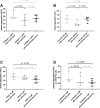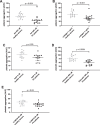The Impact of Convertase Subtilisin/Kexin Type 9 Monoclonal Antibodies with and without Apheresis on Platelet Aggregation in Familial Hypercholesterolemia
- PMID: 37129685
- PMCID: PMC11438737
- DOI: 10.1007/s10557-023-07455-y
The Impact of Convertase Subtilisin/Kexin Type 9 Monoclonal Antibodies with and without Apheresis on Platelet Aggregation in Familial Hypercholesterolemia
Abstract
Background and aims: It is well known that elevated cholesterol is associated with enhanced platelet aggregation and patients suffering from familial hypercholesterolemia (FH) have a high risk of thrombotic cardiovascular events. Although decreasing cholesterol level is associated with attenuation of platelet hyperactivity, there are currently no data on the effect of convertase subtilisin/kexin type 9 monoclonal antibodies (PCSK9ab) on platelet reactivity in FH. The aim of the study was to analyse the impact of different therapies including PCSK9ab on platelet aggregation in FH.
Methods: This study enrolled all 15 patients treated in the University Hospital Hradec Králové for FH. PCSK9ab have been administered in 12 of 15 patients while 8 patients were also undergoing lipid apheresis. Blood samples from all patients including pre- and post-apheresis period were tested for platelet aggregation triggered by 7 inducers, and the effect of 3 clinically used drugs (acetylsalicylic acid, ticagrelor and vorapaxar) was compared as well.
Results: Although apheresis decreased the reactivity of platelets in general, platelet responses were not different between non-apheresis patients treated with PCSK9ab and apheresis patients (post-apheresis values) with the exception of ristocetin. However, when compared to age-matched healthy population, FH patients had significantly lower platelet aggregation responses to 4 out of 7 used inducers and higher profit from 2 out of 3 used antiplatelet drugs even after exclusion of FH patients regularly receiving conventional antiplatelet treatment.
Conclusion: This study showed for the first time the suitability of PCSK9ab treatment for reduction of platelet reactivity in FH patients.
Keywords: ADP receptor; Acetylsalicylic acid; Antiplatelet; Dyslipidemia; Ticagrelor; Vorapaxar.
© 2023. The Author(s).
Conflict of interest statement
The authors declare no competing interests.
Figures





Similar articles
-
The Effect of 4-Methylcatechol on Platelets in Familial Hypercholesterolemic Patients Treated with Lipid Apheresis and/or Proprotein Convertase Subtilisin Kexin 9 Monoclonal Antibodies.Nutrients. 2023 Apr 11;15(8):1842. doi: 10.3390/nu15081842. Nutrients. 2023. PMID: 37111061 Free PMC article.
-
Coagulation in familial hypercholesterolemic patients: effect of current hypolipidemic treatment and anticoagulants.Naunyn Schmiedebergs Arch Pharmacol. 2025 Jun;398(6):7343-7352. doi: 10.1007/s00210-024-03740-1. Epub 2025 Jan 3. Naunyn Schmiedebergs Arch Pharmacol. 2025. PMID: 39751820
-
Removal of plasma mature and furin-cleaved proprotein convertase subtilisin/kexin 9 by low-density lipoprotein-apheresis in familial hypercholesterolemia: development and application of a new assay for PCSK9.J Clin Endocrinol Metab. 2015 Jan;100(1):E41-9. doi: 10.1210/jc.2014-3066. J Clin Endocrinol Metab. 2015. PMID: 25313916
-
Familial Hypercholesterolemia and Lipoprotein Apheresis.J Atheroscler Thromb. 2019 Aug 1;26(8):679-687. doi: 10.5551/jat.RV17033. Epub 2019 Jun 22. J Atheroscler Thromb. 2019. PMID: 31231083 Free PMC article. Review.
-
Role of PCSK9 Inhibitors in High Risk Patients with Dyslipidemia: Focus on Familial Hypercholesterolemia.Curr Pharm Des. 2018;24(31):3647-3653. doi: 10.2174/1381612824666181010124657. Curr Pharm Des. 2018. PMID: 30317985 Review.
References
-
- Siegel-Axel D, Daub K, Seizer P, Lindemann S, Gawaz M. Platelet lipoprotein interplay: trigger of foam cell formation and driver of atherosclerosis. Cardiovasc Res. 2008;78(1):8–17. - PubMed
-
- Singh S, Bittner V. Familial hypercholesterolemia–epidemiology, diagnosis, and screening. Curr Atheroscler Rep. 2015;17(2):482. - PubMed
-
- Alonso R, Argüeso R, Álvarez-Baños P, et al. Familial hypercholesterolemia and lipoprotein(a): two partners in crime? Curr Atheroscler Rep. 2022;24(6):427–34. - PubMed
MeSH terms
Substances
Grants and funding
LinkOut - more resources
Full Text Sources
Medical
Miscellaneous

